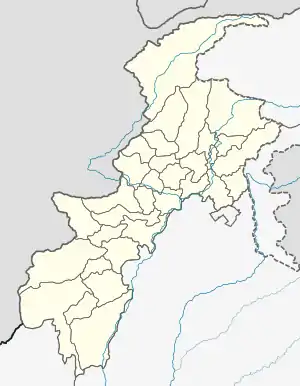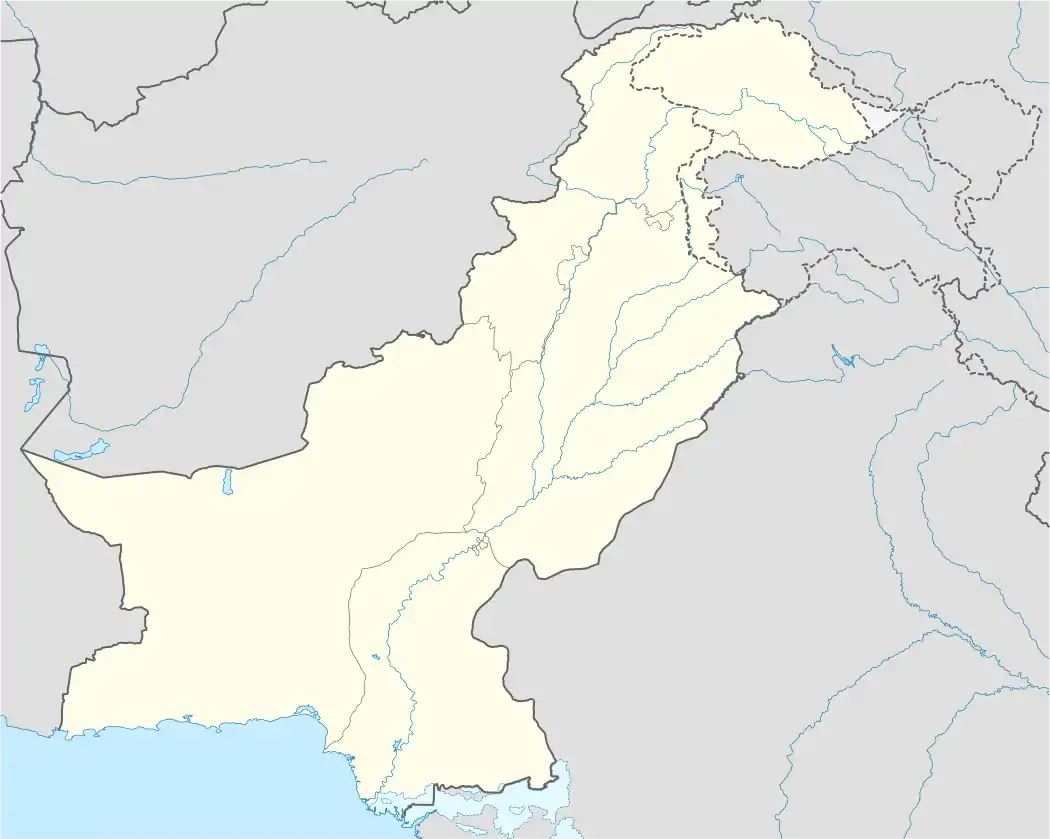Garhi Habibullah
Garhi Habibullah is a town and union council (an administrative subdivision) of Mansehra District in the Khyber-Pakhtunkhwa province of Pakistan.[1] It is located in Mansehra Tehsil and lies to the east of the district capital Mansehra, towards the Kashmir frontier (near to Muzaffarabad the capital of Azad Kashmir). It is in an area affected by the 2005 Kashmir earthquake. It is named after (Ex-Chief Of Swati) Habibullah Khan. Old name of Garhi Habibullah was Garhi Saadat Khan named as such by the founder of this town who was ruler of Pakhli(1762-1780) and nominal Chief Of Swati Pashtun Tribe.[2] Hindko Language is spoken in this town. [3][4]
Garhi Habibullah | |
|---|---|
Union council and town | |
| Garhi Habibullah Khan | |
 Garhi Habibullah View from Aznali Hills photograph credit : Waleed Khan | |
 Garhi Habibullah Location in Pakistan  Garhi Habibullah Garhi Habibullah (Pakistan) | |
| Coordinates: 34.4014°N 73.3803°E | |
| Country | Pakistan |
| Region | Khyber-Pakhtunkhwa |
| District | Mansehra District |
| Government | |
| • Habibullah Khan (chief of tribe Khankhail) | Sahadat Khan |
| Time zone | UTC+5 (PST) |
| Area code(s) | 0997 |
References
- Tehsils & Unions in the District of Mansehra - Government of Pakistan Archived July 18, 2011, at the Wayback Machine
- Earthquake Affected Area Overview - United Nations Joint Logistics Centre Archived September 13, 2012, at Archive.today
- Localities In Garhi Habibullah:
- Seri
- Naral
- Babar Colony
- Batsing
- Hissari \ Hissarak
- Jabbi
- Shahmori
- Sughdar
- Ponrh
- Tribe Of Habibullah Khan and their invansion of Hazara: The tribe of Habibullah Khan are Swati, a famous tribe, dwelling in the districts of Batagram and Mansehra of the North-West Frontier Province of Pakistan, a mountainous area that contains Pakhli, Agror, Thakot, Balakot,Garhi Habibullah, Kaghan, Black Mountain of Hazara and Allai. Swatis also ruled Kashmir from 14th-16th century A.D. The first ever muslim ruler of Kashmir was Shah Mir Baba a Swati, by whom Islam became major religion of Kashmir. "Swati" is a tribe which occupied the area of Swat, Dir, Bajawar, and parts of Charsadda, before Yusafzais. Swatis are race of Dehqan origins and would speak Dari language when they were across Indus in Swat. The Swatis' arrival in Hazara from Swat led to their fighting campaigns against the local Karlugh Turks and also Hindu Domaas in which Swatis were victorious. When the Timurid King of Kabul, Mirza Ulagh Beg evicted Yousafzais from Kabul, they took refuge in Swat, Bajawar and Peshawar with Swatis and Dilazaks. Finding an opportunity Yusufzais latter in times of Emperor Babur sided with the Mughals, and the tribes fought an intense guerilla war against each other for more than two decades, culminating in the withdrawal of the Swatis from their lands, and they migrated to Nindhiyar and Pakhli now part of Hazara Division in Khyber Pukhtunkhawa. Emperor Zaheeruddin Babar himself took part in conquering their strongholds as Gabri Fort of Bajawar and Manglawar Fort at Swat. Swatis accompanied Ghoris in their conquest of Swat. They are tribe from which Sultans of Peech, Kunar in Afghanistan, belonged. Swati is one of the largest land-owning tribes in Hazara and their population is widely spread throughout Mansehra,Garhi Habibullah, Balakot, Kaghan,Batagram and all the way to the Eastern slopes of the Black Mountain of Hazara and the secluded valley of Allai. Politically and economically, they are a tribe of great consequence in the region and numbered 33,000 individuals according to the Census Report of 1911. This number didn't include Swatis of Battagram then known as Hazara Agency in British times. Foundation of Garhi Habibullah: Saadat Khan Swati was the first ruler of Pakhli (1762-1780), during the reign of Durranis. One of his sons, Najeebullah Khan Swati, was martyred in the famous War of Mangal against the Sikhs. The family of Saadat Khan ruled this area and contributed a lot to the development of the area. He was conferred upon the title of Khan of Garhi by Swatis of Garhi and confirmed as such from the Durrani Court of Ahmad Shah Abdali. Saadat Khan built a fort which he named Garhi Saadat Khan after his death Habibullah Khan became the Chief of the Swati tribe and the fort consequently got famous with his name as Garhi Habibullah. Present figurehead Chief Of Swatis is Habibullah Khan (II). Some well-known khels and subsections of the Swatis are Jahangiri, Malkals,KhanKhel, Arghushal, Lughmani Deeshan, Beror, Jadoor, NajabatKhel, ToarKhel, Kuchelai, Musa Khel, Narors, Shamkori, SanaKhel, Sumla Khel, Warozai, KhazanKhel, Sherkhani,GhaziKhel,MeerKhan Khel and KhwajaKheli, Barkhan khel or Barkhani and Ghoris. Pashto is spoken and understood almost in the whole Swati Tappa. Swatis are divided into four great clans, Gabri, Mamiali, Mitravi and Toar. These groups are further divided into many subsections and Khels. Swatis are bilinguals and can speak Hindko in addition to their mother tongue Pashto. They observe the tribal code of honor very strictly and call it Swatiwali.
- Imperial Gazetteer of India P 319
- History of Afghans by Dorn B.
- Mountstuart Elphinstone (1843). An Account of the Kingdom of Caubul
- Raverty H.G (1888). Notes on Baluchistan and Afghanistan
- Hazara Gazetteer 1883 and 1907.
- Tajik Swati aur Mamlikat e Gabar by Prof. Akhtar.
- Tazkira by Roshan Khan.
- Tareekh e Hafiz Rehmat Khan
- Tareekh e Hazara by Sher Bahadur Khan Panni.
This article is issued from Wikipedia. The text is licensed under Creative Commons - Attribution - Sharealike. Additional terms may apply for the media files.
